Experimental and Theoretical Study on Local Damage of Reinforced Concrete Column under Rectangular Charge
Abstract
:1. Introduction
2. Explosion Experiment and Result Analysis
2.1. RC Columns Characteristics
2.2. Experiment Setup
2.3. Experiment Results and Analysis
- The test compared the results of RC column destruction under the C30 and C40 conditions for two groups, as shown in Figure 6. After upgrading the concrete strength from C30 to C40, local damage to the RC columns was reduced to a certain degree, and the steel deformation and concrete damage gap decreased. In the near-field explosion, the side concrete damage to the C40 concrete was minor. The data are compared in Figure 7. Under contact explosion conditions, the effect of the increased concrete strength on improving the RC column’s blast resistance was very small.
- The scaled distances of the 100, 150, and 200 mm standoff distances were 0.170, 0.238, and 0.305 m/kg1/3, respectively, while the mass of the TNT charge was 0.4 kg. The test results are shown in Figure 8. For the C40 column at a scaled distance of 0.238 m/kg1/3, the damage was smaller than that of the C30 column at a scaled distance of 0.305 m/kg1/3. Furthermore, increasing the concrete strength effectively reduced concrete damage on the column surface under a large standoff (≥150 mm). At a scaled distance of 0.238 m/kg1/3, the blast load only caused slight damage to the concrete protective layer; at a scaled distance of 0.170 m/kg1/3, the concrete protective layer on the blast-facing surface of the RC column was severely damaged, but the reinforcement was not significantly deformed, and the concrete in the core area was intact. Under contact blast conditions (a scaled distance of 0.034 m/kg1/3), the RC column showed severe concrete damage and reinforcement deformation.
- Different axial loads were transmitted to the RC column under the same explosion conditions, and the test results are shown in Figure 9. The collapse on the side of the RC column without an axial load formed two inverted triangles. When the axial pressure was 50 kN, the concrete constraint effect was enhanced by the axial load, and the peeling surface of the side concrete protective layer was basically flush with the stirrup. A comparison of two tests, namely, C30-S-0.4-0-50 and C30-S-0.4-0-75, revealed that when the axial load increased to 75 kN, the damage to the column intensified. While the standoff was 100 mm, increasing the axial load effectively reduced the damage to the center of the column surface.
- The 0.2 kg TNT caused severe damage to the column protective layer under contact explosion conditions, while the concrete in the core area only sustained a small amount of damage. When the TNT mass was 0.4 kg, the deformation of the steel bars intensified, and the concrete in the core area was severely damaged. When the TNT mass was 0.6 kg, the damage to the concrete core area exceeded 50%. In addition to the blast-facing surface, both sides of the core area endured serious damage. When the TNT mass was 0.8 kg, a significant angle on the supports could be observed; the concrete in the core area and the internal longitudinal bars were completely damaged. In addition, the shape of the explosive seriously impacted the damage to the column (C30-S-0.6-0-0). Ignoring the impact of column length on the damage, the contact area between the explosive and the column was large, and the scaled distance was small, causing serious damage, as shown in Figure 10.
- Under contact explosion conditions (C40-S-0.4-0-0 and C40-L-0.4-0-0), the difference in local damage to the columns was relatively small; furthermore, the difference in concrete damage was also relatively small. When the concrete in the core area was damaged, there was a clear correlation with the transverse reinforcement. Given the different transverse reinforcement arrangements when the short and long columns exploded at the center, certain differences in the damaged area were observed. However, the core damage area was limited by the transverse reinforcement, and the damage length was similar. This phenomenon also obviously occurred when the mass of the TNT increased and the damage was severe, as shown in Figure 11.
3. Numerical Study
3.1. Numerical Model Setup
3.2. Material Models
3.3. Model Verification
3.4. Numerical Results and Discussion
3.4.1. Length of Column and Standoff Effect
3.4.2. Effects of Stirrup Distance and Location of Explosive
4. Damage Prediction
4.1. Contact Explosive Load
4.2. Damage Prediction Model
4.2.1. Damage Evolution and Basic Model
- The explosion immediately acts on the RC column upon charge detonation. The portion of the RC column in direct contact with the charge enters a plastic flow state as a result of the substantially elevated peak pressure exceeding the material yield strength; this section of the material is referred to as the “initial explosion body”. The bars in the initial explosion body can be ignored, and the concrete within the initial explosion body is subject to complete destruction, thus rendering the confinement effect of the bars on the concrete negligible.
- The external concrete in the initial explosive body experiences compression upon impact, causing internal void collapse and compaction, consequently leading to heightened compressive strength. As the stress wave propagates within the column, the material transitions from compaction hardening to pore crushing. Consequently, the compressive failure crater is formed, as depicted in Figure 20.
- The stress wave continues to propagate through the column, reflected as a rarefaction wave at the bottom and lateral face. When the tensile stress acting on the lateral and bottom concrete of the column exceeds its ultimate tensile strength, it leads to tensile failure, resulting in cracking and spalling.
4.2.2. Correction of Initial Explosion Body
4.2.3. Propagation and Compressive Damage
4.2.4. Equivalent Transmission via Reinforcement
4.2.5. Reflection and Spalling
4.3. Verification of the Predictive Model
5. Conclusions
- Increasing the concrete strength by 10 MPa (C30 to C40) does not substantially improve the blast resistance of RC columns, while increasing the blast height by 100 mm substantially reduces the local damage suffered by RC columns.
- When the axial load is 50 kN, the concrete constraint effect is enhanced because of the axial load, and the peeling surface of the side concrete protective layer is basically flush with the stirrup. A comparison of two tests, namely, C30-S-0.4-0-50 and C30-S-0.4-0-75, revealed that when the axial load is increased to 75 kN, the damage to the column is intensified. While the standoff is 100 mm, increasing the axial load can effectively reduce the damage to the center of the column surface.
- When the concrete in the core area is damaged, a clear correlation with the transverse reinforcement exists. The numerical simulation results indicate that the reinforcement effect diminishes when the distance between the transverse reinforcement and the explosive is reduced. Consequently, the local damage at 80 mm spacing is less than that at 70 mm. Based on the numerical simulation analyzing the shock wave attenuation in the transverse reinforcement, we can conclude that the transverse reinforcement arrangement affects the length of damage.
- The attenuation coefficient of the concrete transverse reinforcement section, derived from a one-dimensional stress wave calculation model, is 0.6. After accounting for the attenuation effects in the transverse reinforcement section, the model can accurately simulate the concrete protective layer on the back blasting surface spalling while the concrete core remains intact when the RC column does not experience penetration damage.
- The damage prediction model for RC columns developed in this study can accurately forecast local damage caused by contact explosions, with an error margin of no more than 20% compared with experimental results. The model accounts for the shape gain of explosives; however, this gain is still somewhat conservative and has not been systematically validated concerning the reinforcement and material strength of reinforced concrete structures. Consequently, the applicability of this model to other contact explosion scenarios remains unverified.
Author Contributions
Funding
Data Availability Statement
Conflicts of Interest
References
- Dua, A.; Braimah, A.; Kumar, M. Contact explosion response of RC columns: Experimental and numerical investigation. Proc. Inst. Civ. Eng.-Struct. Build. 2020, 173, 799–820. [Google Scholar] [CrossRef]
- ASCE Blast Protection of Buildings; American Society of Civil Engineers, Structural Engineering Institute: Reston, VA, USA, 2011.
- Shin, J.; Whittaker, A.S.; Cormie, D.; Wilkinson, W. Numerical modeling of close-in detonations of high explosives. Eng. Struct. 2014, 81, 88–97. [Google Scholar] [CrossRef]
- Hyde, D.W. Microcomputer Programs CONWEP and FUNPRO, Applications of TM 5-855-1, ‘Fundamentals of Protective Design for Conventional Weapons’ (User’s Guide); US Army Engineer Waterways Experiment Station: Vicksburg, MS, USA, 1988. [Google Scholar]
- Sherkar, P.; Shin, J.; Whittaker, A.; Aref, A. Influence of charge shape and point of detonation on blast-resistant design. J. Struct. Eng. 2016, 142, 04015109. [Google Scholar] [CrossRef]
- Dua, A.; Braimah, A.; Kumar, M. Contact explosion response of reinforced concrete columns: Experimental and validation of numerical model. Build. Tomorrow Soc. 2018, 173, 1–10. [Google Scholar]
- Dua, A.; Braimah, A.; Kumar, M. Experimental and numerical investigation of rectangular reinforced concrete columns under contact explosion effects. Eng. Struct. 2020, 205, 109891. [Google Scholar] [CrossRef]
- Mejía, N.; Peralta, R.; Tapia, R.; Durán, R.; Sarango, A. Damage assessment of RC columns under the combined effects of contact explosion and axial loads by experimental and numerical investigations. Eng. Struct. 2022, 254, 113776. [Google Scholar] [CrossRef]
- Cai, R.; Li, Y.; Zhang, C.; Cao, H.; Qi, H.; Mao, J. Size effect on reinforced concrete slabs under direct contact explosion. Eng. Struct. 2022, 252, 113656. [Google Scholar] [CrossRef]
- Yang, C.; Jia, X.; Huang, Z.; Zhao, L.; Shang, W. Damage of full-scale reinforced concrete beams under contact explosion. Int. J. Impact Eng. 2022, 163, 104180. [Google Scholar] [CrossRef]
- Chiquito, M.; López, L.M.; Castedo, R.; Santos, A.P.; Pérez-Caldentey, A. Full-Scale Field Tests on Concrete Slabs Subjected to Close-In Blast Loads. Buildings 2023, 13, 2068. [Google Scholar] [CrossRef]
- Kyei, C.; Braimah, A. Effects of transverse reinforcement spacing on the response of reinforced concrete columns subjected to blast loading. Eng. Struct. 2017, 142, 148–164. [Google Scholar] [CrossRef]
- Riedel, W.; Thoma, K.; Hiermaier, S.; Schmolinske, E. Penetration of reinforced concrete by BETA-B-500 numerical analysis using a new macroscopic concrete model for hydrocodes. In Proceedings of the 9th International Symposium on the Effects of Munitions with Structures, Berlin-Strausberg, Germany, 3–4 May 1999; p. 315. [Google Scholar]
- Codina, R.; Ambrosini, D.; de Borbón, F. Experimental and numerical study of a RC member under a close-in blast loading. Eng. Struct. 2016, 127, 145–158. [Google Scholar] [CrossRef]
- Abladey, L.; Braimah, A. Near-field explosion effects on the behaviour of reinforced concrete columns: A numerical investigation. Int. J. Prot. Struct. 2014, 5, 475–499. [Google Scholar] [CrossRef]
- Yan, J.; Liu, Y.; Xu, Z.; Li, Z.; Huang, F. Experimental and numerical analysis of CFRP strengthened RC columns subjected to close-in blast loading. Int. J. Impact Eng. 2020, 146, 103720. [Google Scholar] [CrossRef]
- Shi, Y.; Hao, H.; Li, Z.X. Numerical derivation of pressure–impulse diagrams for prediction of RC column damage to blast loads. Int. J. Impact Eng. 2008, 35, 1213–1227. [Google Scholar] [CrossRef]
- Hong, J.; Fang, Q.; Chen, L.; Kong, X. Numerical predictions of concrete slabs under contact explosion by modified K&C material model. Constr. Build. Mater. 2017, 155, 1013–1024. [Google Scholar]
- Astarlioglu, S.; Krauthammer, T.; Morency, D.; Tran, T.P. Behavior of reinforced concrete columns under combined effects of axial and blast-induced transverse loads. Eng. Struct. 2013, 55, 26–34. [Google Scholar] [CrossRef]
- Li, Q.M.; Meng, H. Pressure-impulse diagram for blast loads based on dimensional analysis and single-degree-of-freedom model. J. Eng. Mech. 2002, 128, 87–92. [Google Scholar] [CrossRef]
- Fallah, A.S.; Louca, L.A. Pressure–impulse diagrams for elastic-plastic-hardening and softening single-degree-of-freedom models subjected to blast loading. Int. J. Impact Eng. 2007, 34, 823–842. [Google Scholar] [CrossRef]
- Dragos, J.; Wu, C. A new general approach to derive normalised pressure impulse curves. Int. J. Impact Eng. 2013, 62, 1–12. [Google Scholar] [CrossRef]
- Rong, Q.; Zhao, Z.; Hou, X.; Jiang, Z. A P-I Diagram Approach for Predicting Dynamic Response and Damage Assessment of Reactive Power Concrete Columns Subjected to Blast Loading. Buildings 2022, 12, 462. [Google Scholar] [CrossRef]
- Yu, R.; Chen, L.; Fang, Q.; Yan, H.; Chen, G. Generation of pressure–impulse diagrams for failure modes of RC columns subjected to blast loads. Eng. Fail. Anal. 2019, 100, 520–535. [Google Scholar] [CrossRef]
- Park, G.K.; Kwak, H.G.; Filippou, F.C. Evaluation of nonlinear behavior and resisting capacity of reinforced concrete columns subjected to blast loads. Eng. Fail. Anal. 2018, 93, 268–288. [Google Scholar] [CrossRef]
- Zhu, W.; Yang, C.; Yin, T.; Jia, J.; Yu, J.; Song, J. Blast resistant performance and damage mechanism of steel reinforced concrete beams under contact explosion. Eng. Struct. 2024, 315, 118472. [Google Scholar] [CrossRef]
- Holgado, D.; Mourão, R.; Montalva, A.; Florek, J. On the Assessment of Reinforced Concrete (RC) Walls under Contact/Near-Contact Explosive Charges: A Deep Neural Network Approach. Buildings 2024, 14, 2683. [Google Scholar] [CrossRef]
- Deng, G.; Yu, X. Numerical study on the case effect of a bomb air explosion. Def. Technol. 2021, 17, 1461–1470. [Google Scholar] [CrossRef]
- Gao, C.; Kong, X.-Z.; Fang, Q.; Hong, J.; Wang, Y. Numerical investigation on free air blast loads generated from center-initiated cylindrical charges with varied aspect ratio in arbitrary orientation. Def. Technol. 2022, 18, 1662–1678. [Google Scholar] [CrossRef]
- Bai, C.; Zhao, X.; Yao, J.; Sun, B.-F. Numerical investigation of the shockwave overpressure fields of multi-sources FAE explosions. Def. Technol. 2021, 17, 1168–1177. [Google Scholar] [CrossRef]
- Cui, J.; Shi, Y.; Li, Z.X.; Chen, L. Failure analysis and damage assessment of RC columns under close-in explosions. J. Perform. Constr. Facil. 2015, 29, B4015003. [Google Scholar] [CrossRef]
- Bischoff, P.H.; Perry, S.H. Compressive behaviour of concrete at high strain rates. Mater. Struct. 1991, 24, 425–450. [Google Scholar] [CrossRef]
- Malvar, L.J.; Crawford, J.E.; Wesevich, J.W.; Simons, D. A plasticity concrete material model for DYNA3D. Int. J. Impact Eng. 1997, 19, 847–873. [Google Scholar] [CrossRef]
- Comité Euro-International du Béton. CEB-FIP Model Code 1990: Design Code; Thomas Telford Publishing: London, UK, 1993. [Google Scholar]
- Malvar, L.J.; Crawford, J.E. Dynamic increase factors for concrete. DTIC Doc. 1998, 1, 1–6. [Google Scholar]
- Fujikake, K.; Aemlaor, P. Damage of reinforced concrete columns under demolition blasting. Eng. Struct. 2013, 55, 116–125. [Google Scholar] [CrossRef]
- Henrych, J.; Abrahamson, G.R. The dynamics of explosion and its use. J. Appl. Mech. 1980, 47, 218. [Google Scholar] [CrossRef]
- Yang, C.; Huang, Z.; Jia, X.; Shang, W.; Chen, T. Analytical model for predicting localized damage in RC beams under contact explosion. Int. J. Impact Eng. 2024, 185, 104870. [Google Scholar] [CrossRef]
- Riedel, W. Beton Unter Dynamischen Lasten: Meso-Und Makromechanische Modelle und Ihre Parameter; EMI: London, UK, 2000. [Google Scholar]
- Tu, H.; Fung, T.C.; Tan, K.H.; Riedel, W. An analytical model to predict the compressive damage of concrete plates under contact detonation. Int. J. Impact Eng. 2019, 134, 103344. [Google Scholar] [CrossRef]
- Tu, H.; Fung, T.C.; Tan, K.H.; Riedel, W. An analytical model to predict spalling and breaching of concrete plates under contact detonation. Int. J. Impact Eng. 2022, 160, 104075. [Google Scholar] [CrossRef]

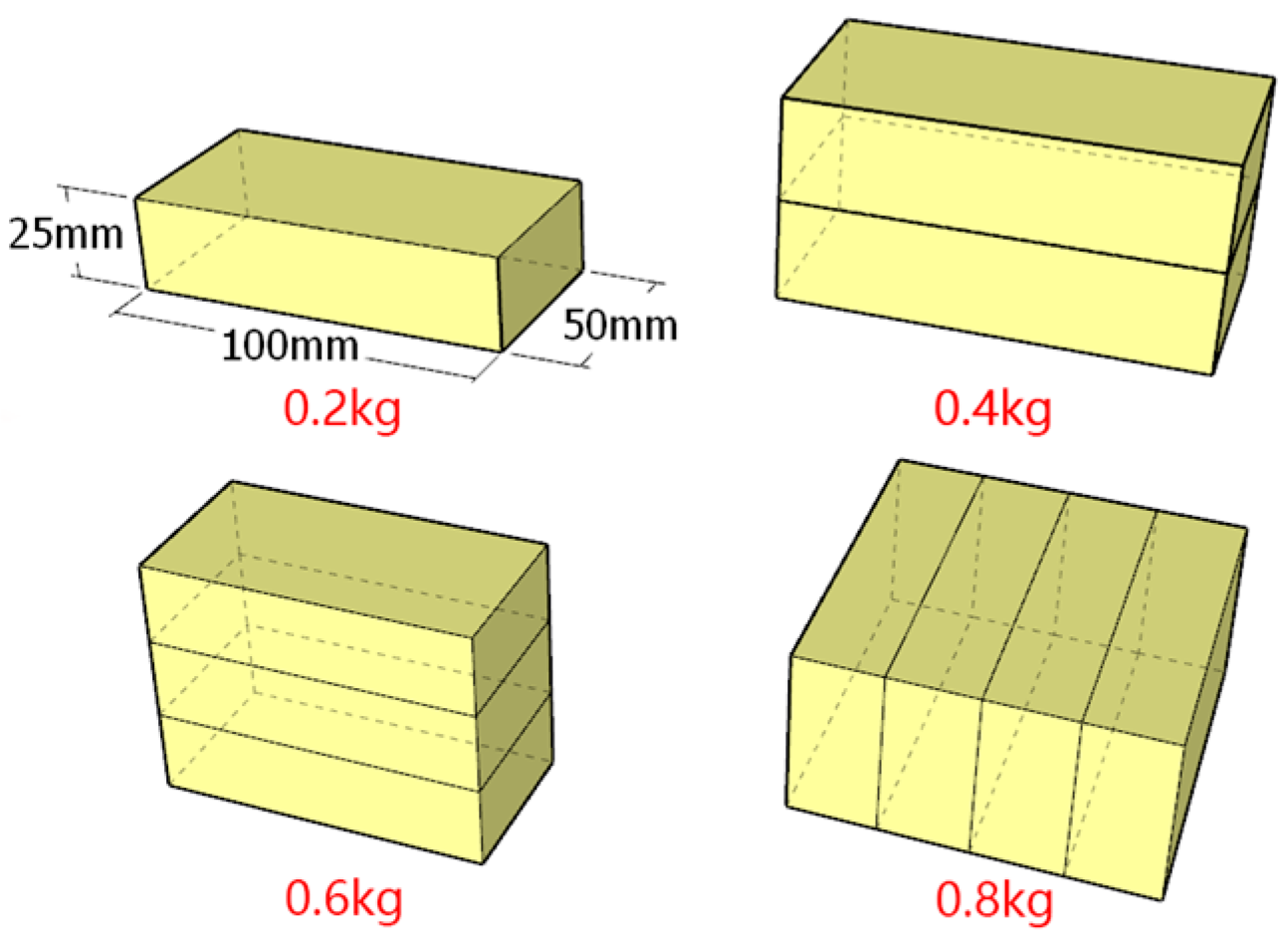


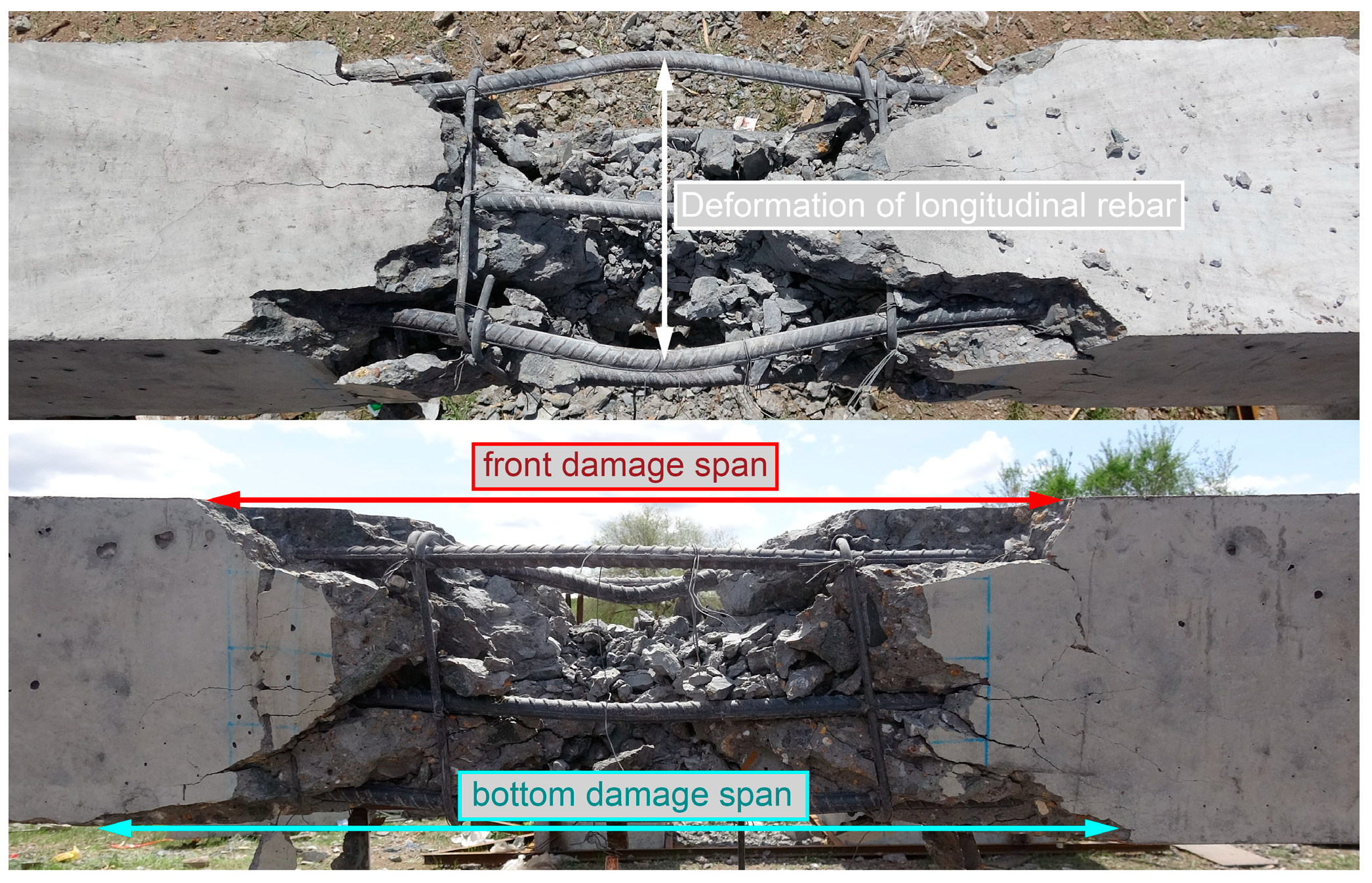
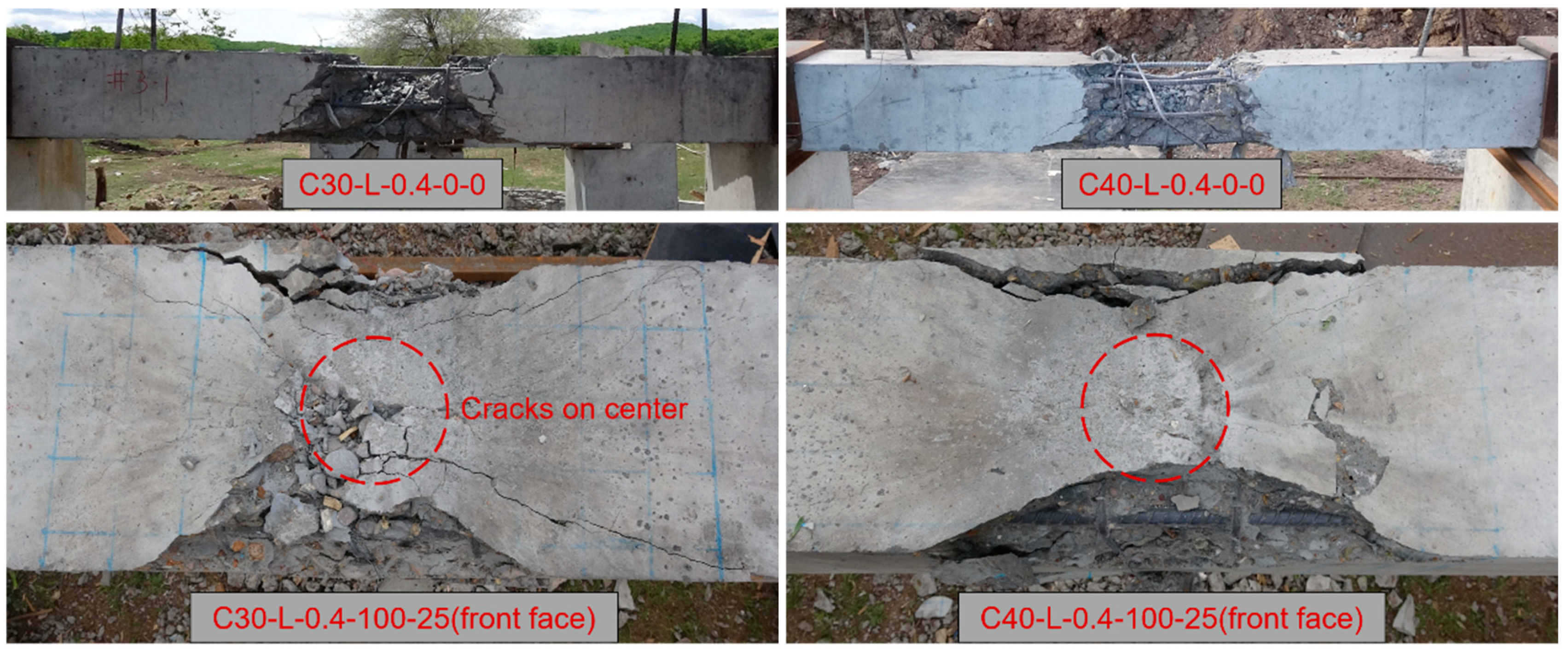



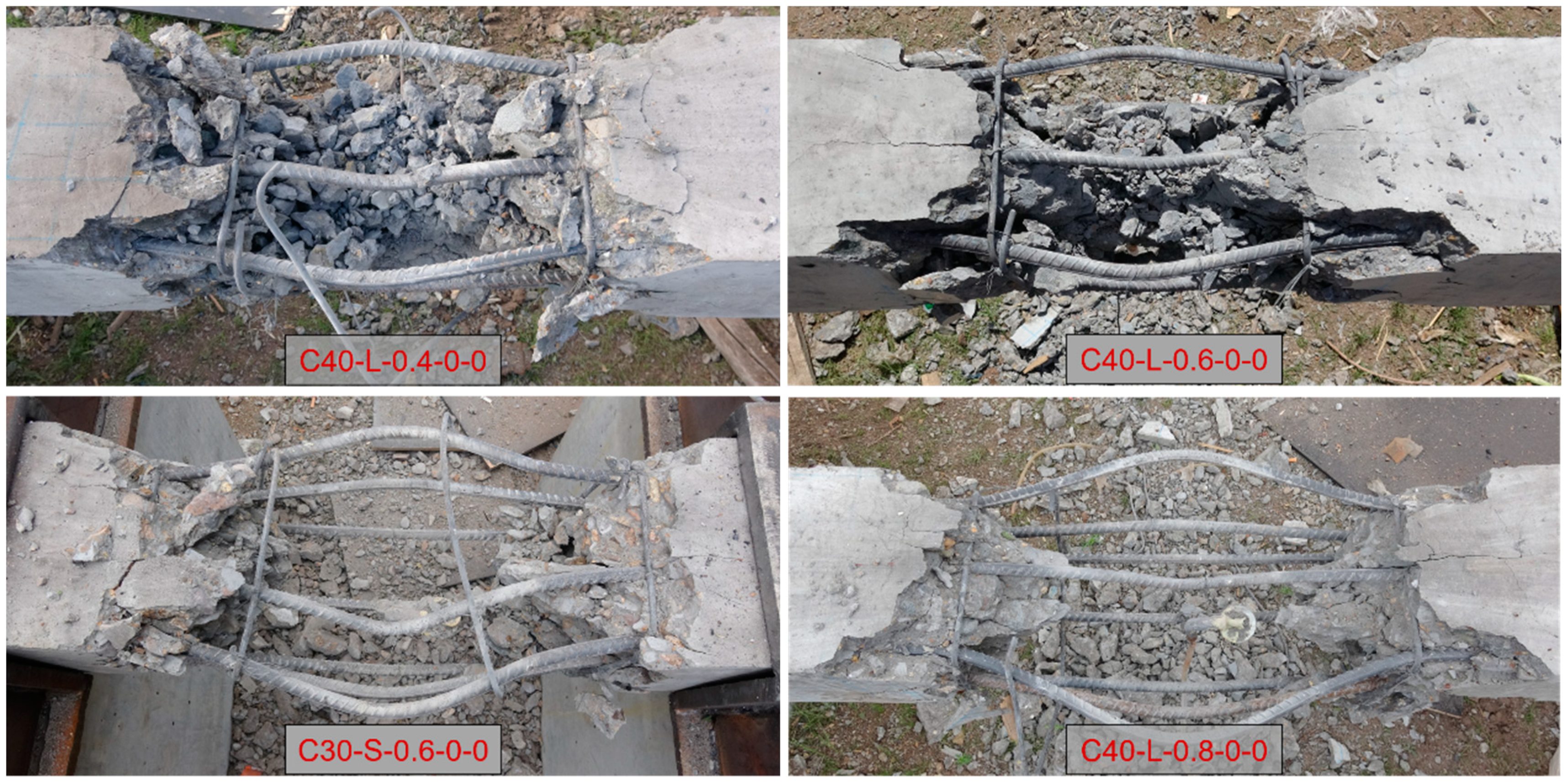



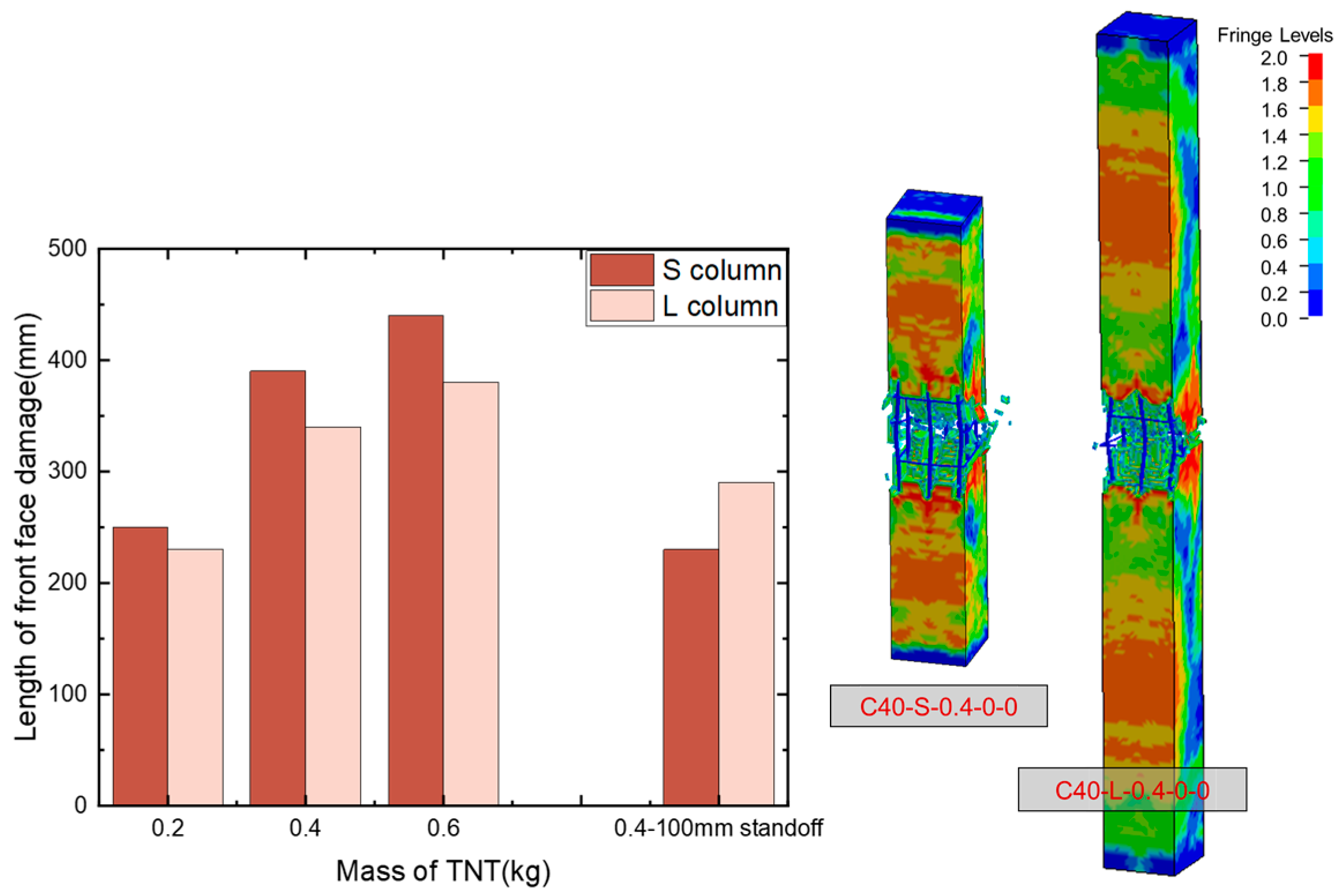

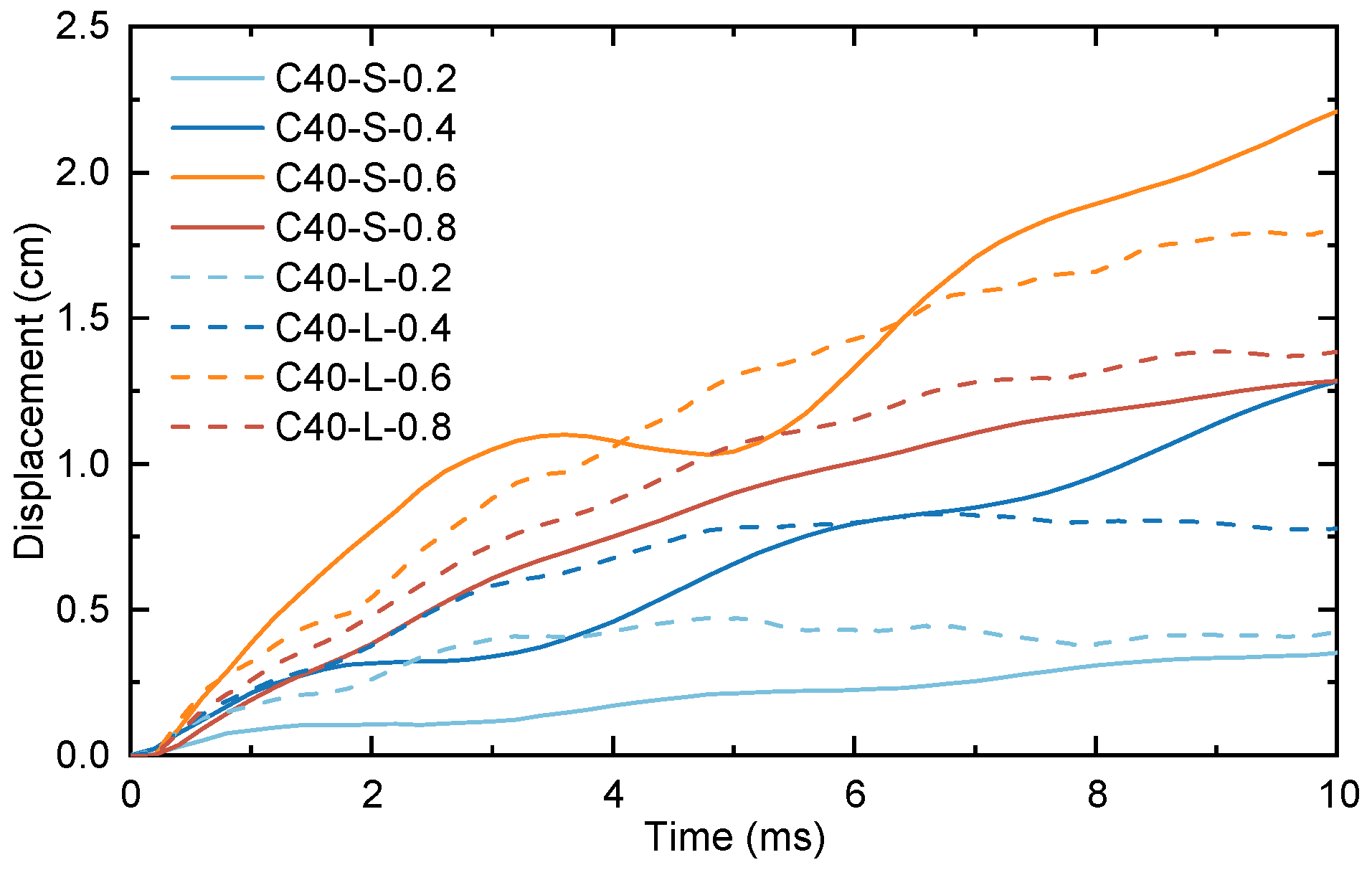

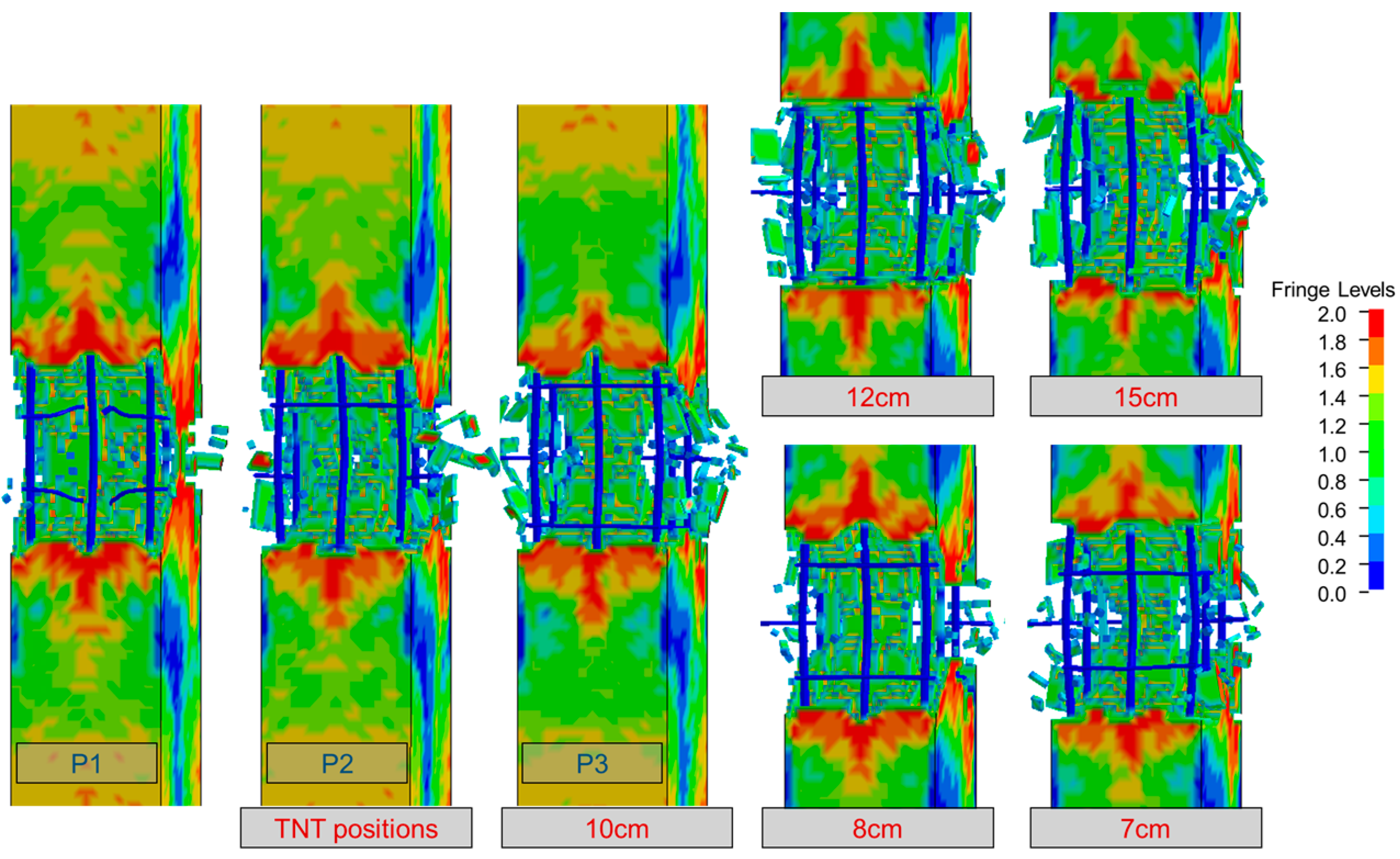


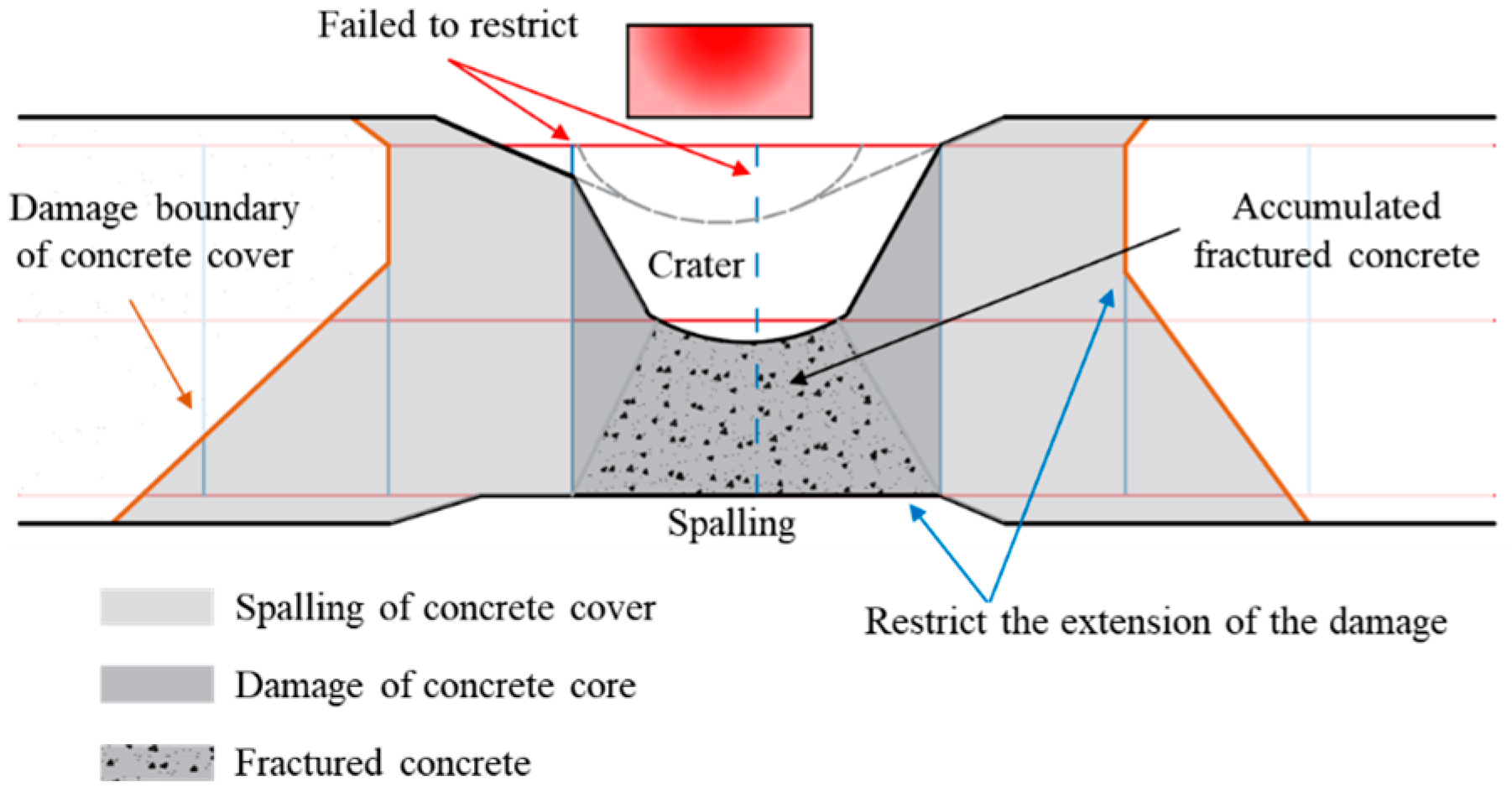

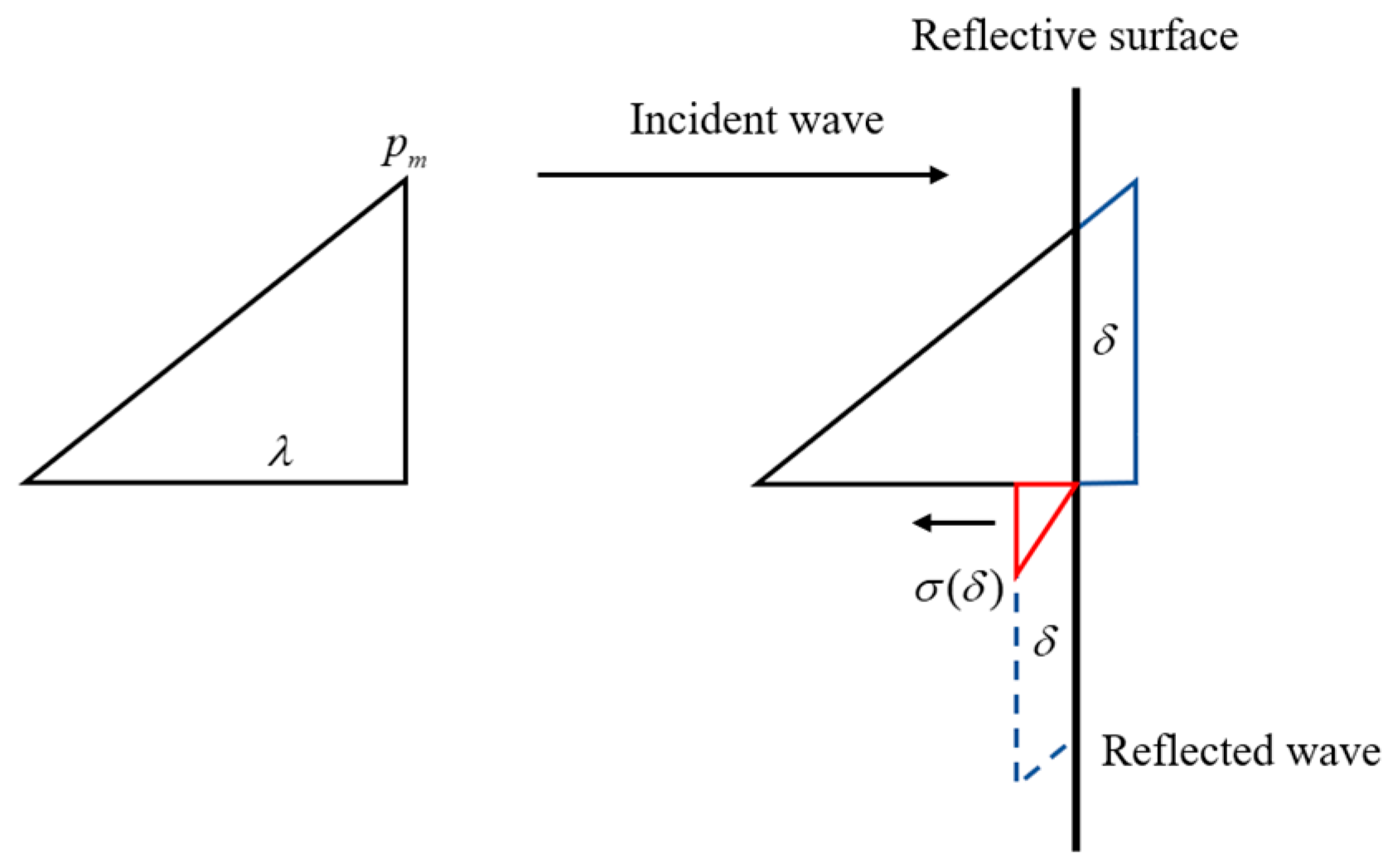


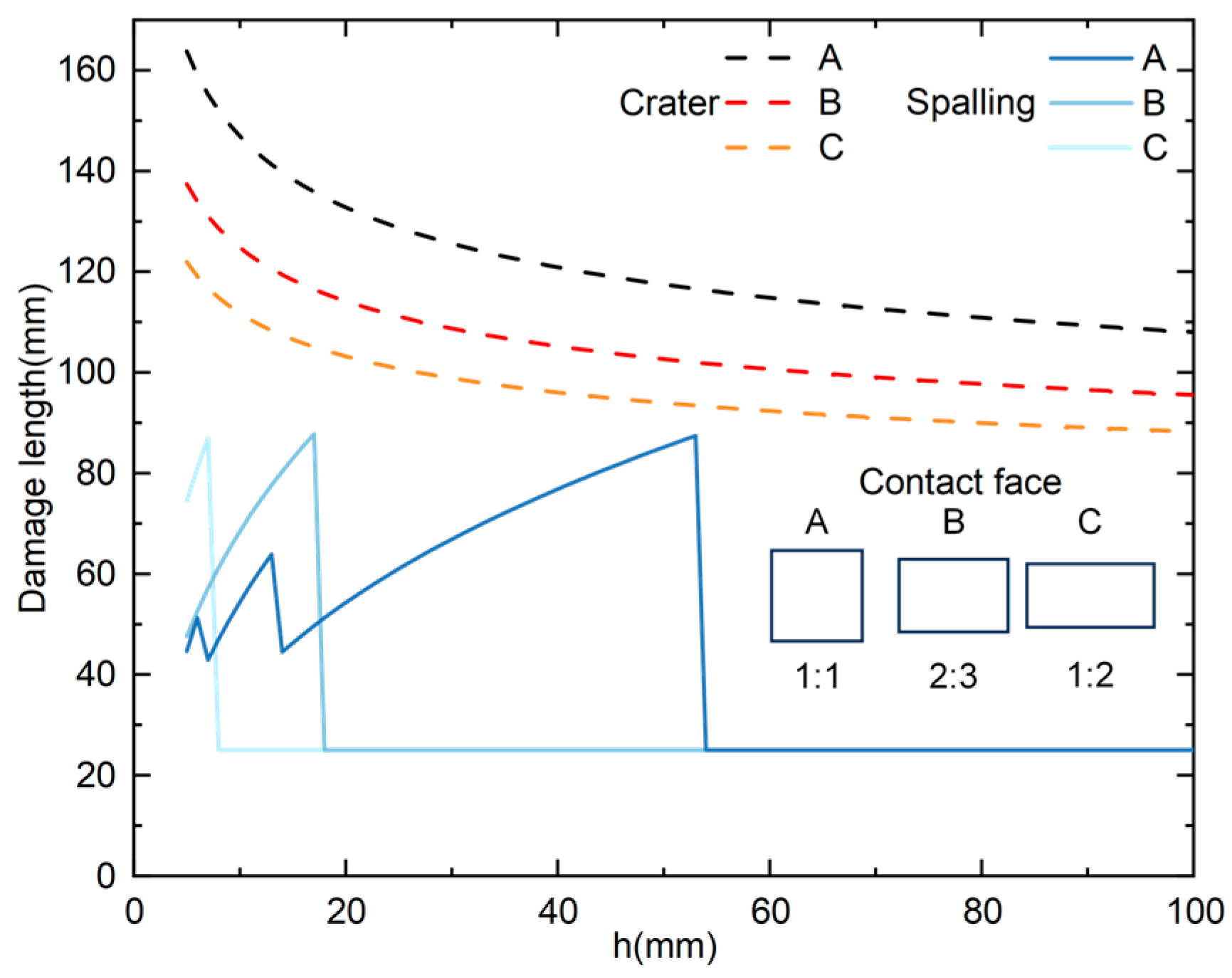
| Length (mm) | (N/mm2) | (N/mm2) | (N/mm2) | (mm2) | (mm2) | Design Value of Axial Load (kN) | |
|---|---|---|---|---|---|---|---|
| 1350 | 1.0 | 14.3 | 30 | 360 | 48,400 | 1230 | 1000 |
| 16.7 | 40 | 1250 | |||||
| 2500 | 0.95 | 14.3 | 30 | 950 | |||
| 16.7 | 40 | 1188 |
| Group | Designation | (mm) | (mm) | (mm) |
|---|---|---|---|---|
| Standoff | C30-S-0.4-200-0 | 220 | / | / |
| C40-S-0.4-100-0 | 490 | 270 | / | |
| C40-S-0.4-150-0 | / | / | / | |
| Axial load and concrete strength | C30-L-0.4-100-25 | 380 | 390 | / |
| C30-L-0.4-100-50 | 440 | 440 | / | |
| C30-L-0.4-100-75 | 490 | 360 | / | |
| C40-L-0.4-100-0 | 440 | 350 | / | |
| C40-L-0.4-100-25 | 450 | 220 | / | |
| TNT mass and axial load | C30-S-0.6-0-0 | 620 | 650 | 310 |
| C30-S-0.4-0-50 | 550 | 570 | 260 | |
| C30-S-0.4-0-75 | 610 | 620 | 260 | |
| C40-S-0.2-0-0 | 560 | 580 | 205 | |
| C40-S-0.4-0-0 | 500 | 560 | 250 | |
| TNT mass and concrete strength | C30-L-0.4-0-0 | 510 | 590 | 230 |
| C40-L-0.4-0-0 | 540 | 580 | 240 | |
| C40-L-0.6-0-0 | 540 | 630 | 250 | |
| C40-L-0.8-0-0 | 740 | 780 | 350 |
| Material Type | Material Model | Main Parameters | |||
|---|---|---|---|---|---|
| Explosive | MAT_HIGH_EXPLOSIVE_BURN | ρ/(g/cm3) | C/(m/s) | A/GPa | B/Gpa |
| 1.63 | 6930 | 373.77 | 3.75 | ||
| R1 | R2 | ω | E0/KJ/m3 | ||
| 4.5 | 0.9 | 0.35 | 6.0 × 106 | ||
| Concrete | MAT_CONCRETE_DAMAGE_REL3 | ρ/(g/cm3) | A0 (MPa) | UCF | LCRATE |
| 2.3 | −30/−40 | 145 | 723 | ||
| RSIZE (MPa) | Failure strain | ||||
| 39,370 | 0.015 | ||||
| Reinforcement | MAT_PLASTIC_KINEMATIC | ρ/(g/cm3) | E/GPa | ν | σy |
| 7.8 | 207 | 0.3 | 400 | ||
| Mass of TNT (kg) | Size of Charge (mm) | Size of Initial Explosion Body (mm) | Depth of Compressive Damage (mm) | Reflected Wave (MPa) | Depth of Spalling (mm) |
|---|---|---|---|---|---|
| 0.2 | 50 × 100 × 25 | 86 × 43 | 100 | 25.8 | 25 |
| 0.4 | 50 × 100 × 50 | 96 × 48 | 105 | 28.8 | 25 |
| 0.6 | 50 × 100 × 75 | 102 × 51 | 108 | 30.6 | 25 |
| 0.6 | 75 × 100 × 50 | 87 × 65 | 122 | 36 | 78 |
| 0.8 | 100 × 100 × 50 | 79 × 79 | 136 | 45 | 93 |
Disclaimer/Publisher’s Note: The statements, opinions and data contained in all publications are solely those of the individual author(s) and contributor(s) and not of MDPI and/or the editor(s). MDPI and/or the editor(s) disclaim responsibility for any injury to people or property resulting from any ideas, methods, instructions or products referred to in the content. |
© 2024 by the authors. Licensee MDPI, Basel, Switzerland. This article is an open access article distributed under the terms and conditions of the Creative Commons Attribution (CC BY) license (https://creativecommons.org/licenses/by/4.0/).
Share and Cite
Wang, Q.; Jia, X.; Huang, Z.; Chen, T.; Shi, Y. Experimental and Theoretical Study on Local Damage of Reinforced Concrete Column under Rectangular Charge. Buildings 2024, 14, 3229. https://doi.org/10.3390/buildings14103229
Wang Q, Jia X, Huang Z, Chen T, Shi Y. Experimental and Theoretical Study on Local Damage of Reinforced Concrete Column under Rectangular Charge. Buildings. 2024; 14(10):3229. https://doi.org/10.3390/buildings14103229
Chicago/Turabian StyleWang, Qiuyang, Xin Jia, Zhengxiang Huang, Taian Chen, and Yujie Shi. 2024. "Experimental and Theoretical Study on Local Damage of Reinforced Concrete Column under Rectangular Charge" Buildings 14, no. 10: 3229. https://doi.org/10.3390/buildings14103229







